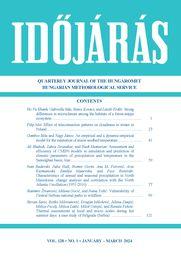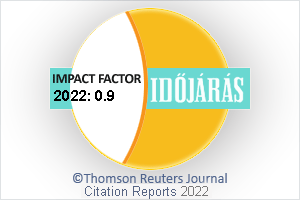Időjárás - Quarterly Journal of the Hungarian Meteorological Service (OMSZ)
Vol. 128, No. 1 * Pages 1–141 * January - March 2024
 |
|
 download [pdf: 5503 KB]
download [pdf: 5503 KB]
Strong differences in microclimate among the habitats of a forest-steppe ecosystem
Ho Vu Khanh, Gabriella Süle, Bence Kovács, and László Erdős
DOI:10.28974/idojaras.2024.1.1 (pp. 1–26)
Ho Vu Khanh, Gabriella Süle, Bence Kovács, and László Erdős
DOI:10.28974/idojaras.2024.1.1 (pp. 1–26)
Effect of teleconnection patterns on cloudiness in winter in Poland
Filip Miś
DOI:10.28974/idojaras.2024.1.2 (pp. 27–39)
Filip Miś
DOI:10.28974/idojaras.2024.1.2 (pp. 27–39)
An empirical and a dynamic-empirical model for the estimation of maize seedbed temperature
Gombos Béla and Nagy János
DOI:10.28974/idojaras.2024.1.3 (pp. 41–57)
Gombos Béla and Nagy János
DOI:10.28974/idojaras.2024.1.3 (pp. 41–57)
Assessment and efficiency of CMIP6 models in simulation and prediction of climatic parameters of precipitation and temperature in the Samalghan basin, Iran
Zahra Zeraatkar, Ali Shahidi, and Hadi Memarian
DOI:10.28974/idojaras.2024.1.4 (pp. 59–74)
Zahra Zeraatkar, Ali Shahidi, and Hadi Memarian
DOI:10.28974/idojaras.2024.1.4 (pp. 59–74)
Characteristics of annual and seasonal precipitation in North Macedonia: change analysis and correlation with the North Atlantic Oscillation (1951–2010)
Ivan Radevski, Julia Hall, Svemir Gorin, Ana M. Petrović Arse Kuzmanoski, Emilija Manevska, and Pece Ristevski
DOI:10.28974/idojaras.2024.1.5 (pp. 75–98)
Ivan Radevski, Julia Hall, Svemir Gorin, Ana M. Petrović Arse Kuzmanoski, Emilija Manevska, and Pece Ristevski
DOI:10.28974/idojaras.2024.1.5 (pp. 75–98)
Vulnerability of Central Serbian national parks to wildfires
Stanimir Živanović, Milena Gocić, and Ivana Tošić
DOI:10.28974/idojaras.2024.1.6 (pp. 99–120)
Stanimir Živanović, Milena Gocić, and Ivana Tošić
DOI:10.28974/idojaras.2024.1.6 (pp. 99–120)
Thermal assessments at local and micro scales during hot summer days: a case study of Belgrade (Serbia)
Stevan Savić, Boško Milovanović, Dragan Milošević, Jelena Dunjić, Milica Pecelj, Milica Lukić, Miloš Ostojić, and Renata Fekete
DOI:10.28974/idojaras.2024.1.7 (pp. 121–141)
Stevan Savić, Boško Milovanović, Dragan Milošević, Jelena Dunjić, Milica Pecelj, Milica Lukić, Miloš Ostojić, and Renata Fekete
DOI:10.28974/idojaras.2024.1.7 (pp. 121–141)
IDŐJÁRÁS - Quarterly Journal

Az IDŐJÁRÁS a HungaroMet Nonprofit Zrt. negyedévenként megjelenő angol nyelvű folyóirata
Megrendelhető a journal.idojaras@met.hu címen.
A szerzőknek szánt útmutató itt olvasható.
Megrendelhető a journal.idojaras@met.hu címen.
A szerzőknek szánt útmutató itt olvasható.









